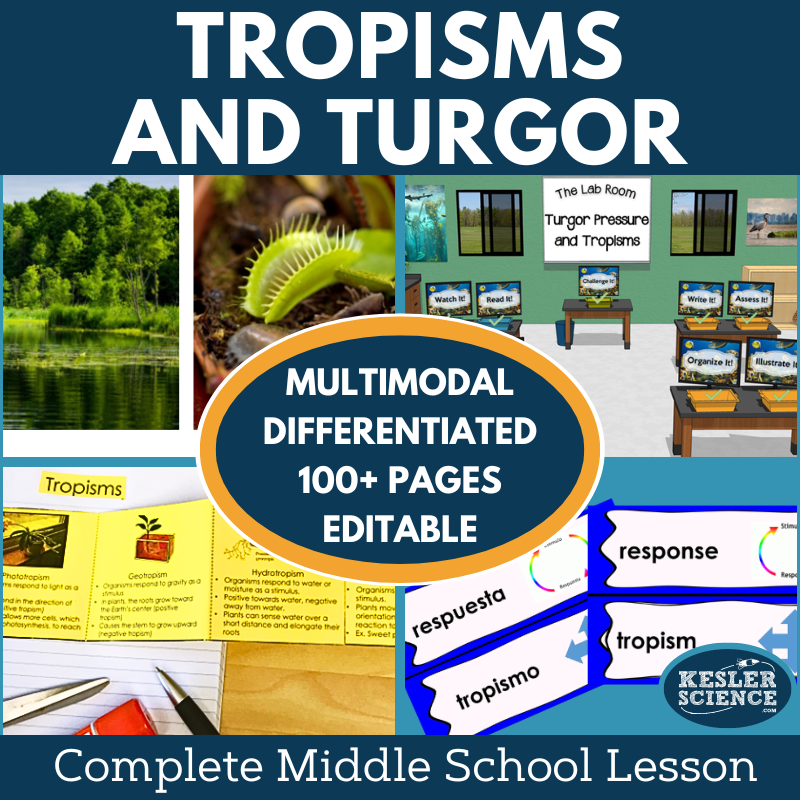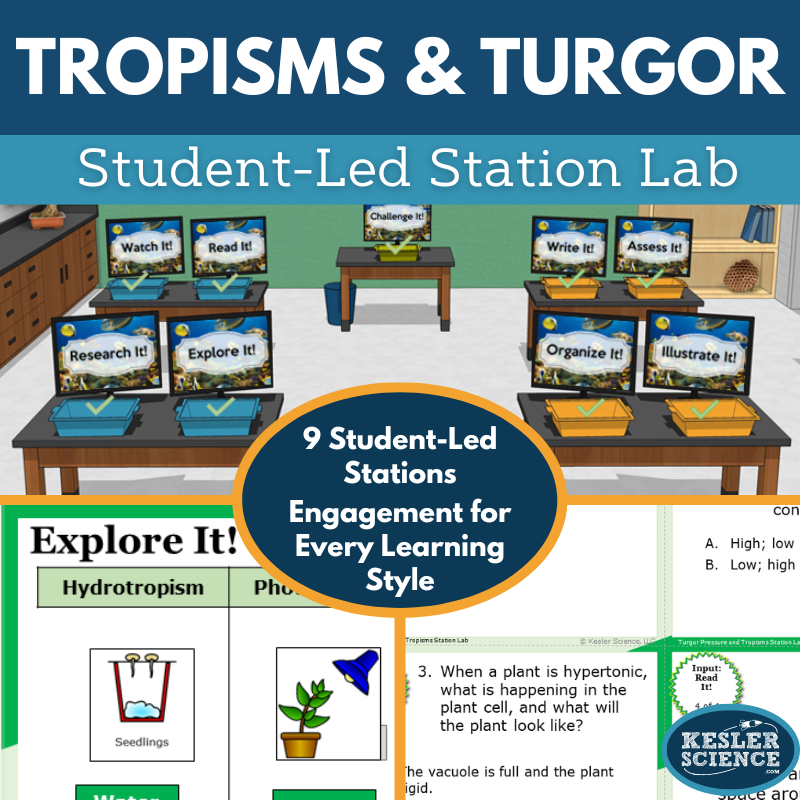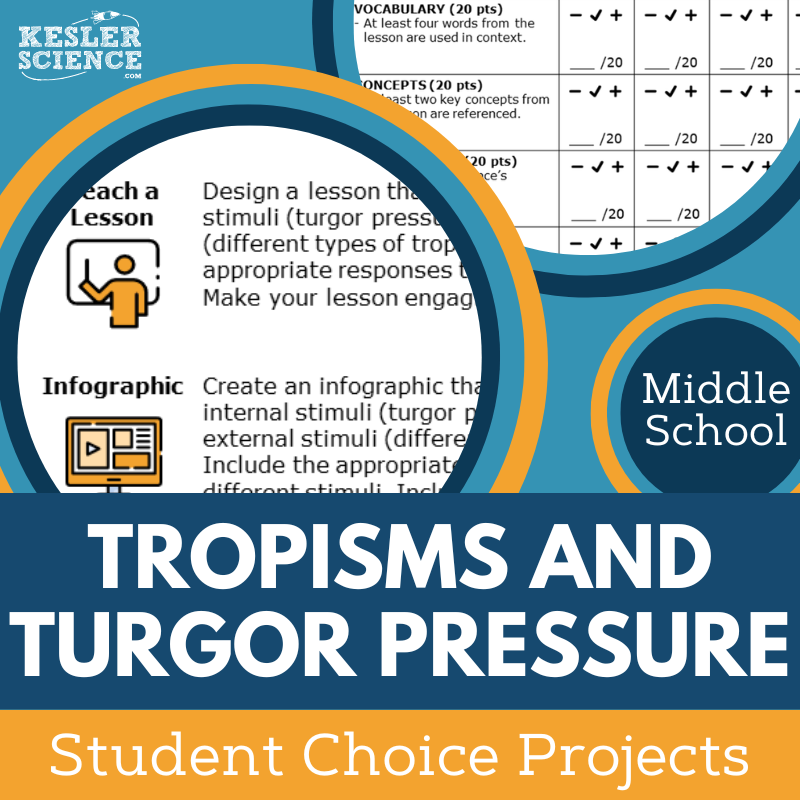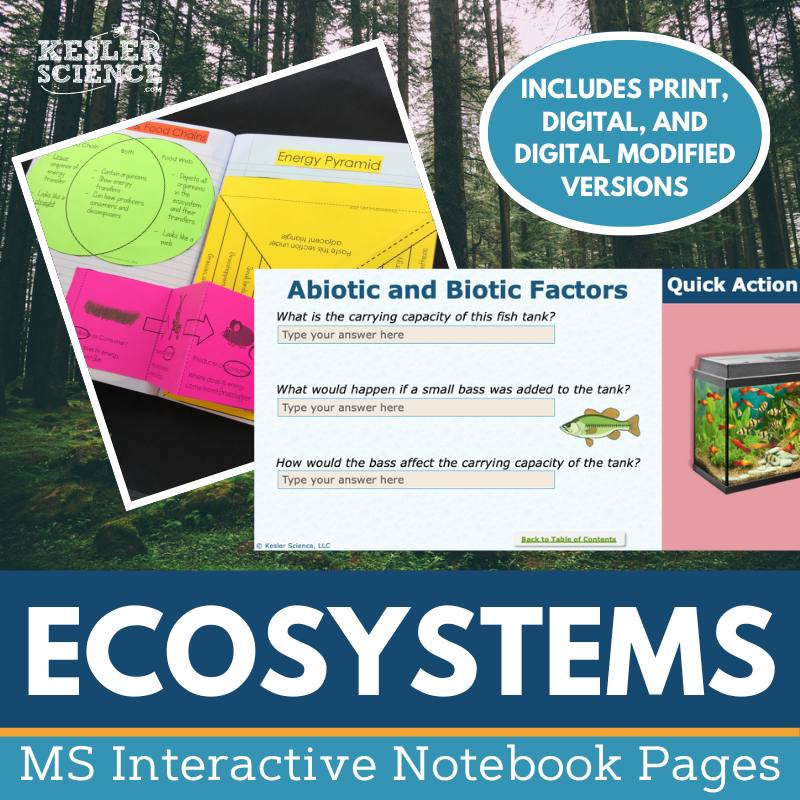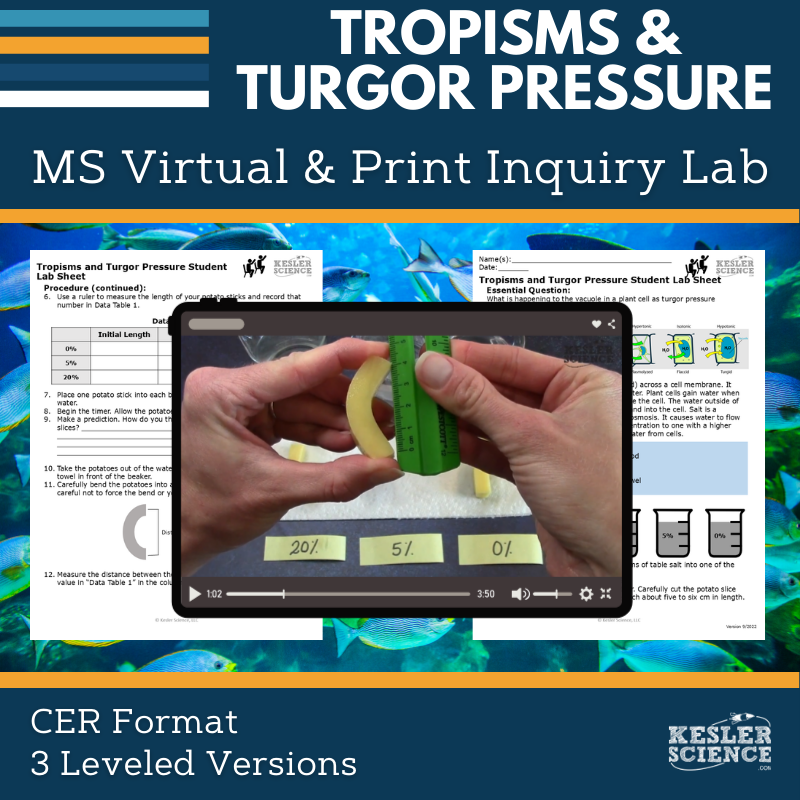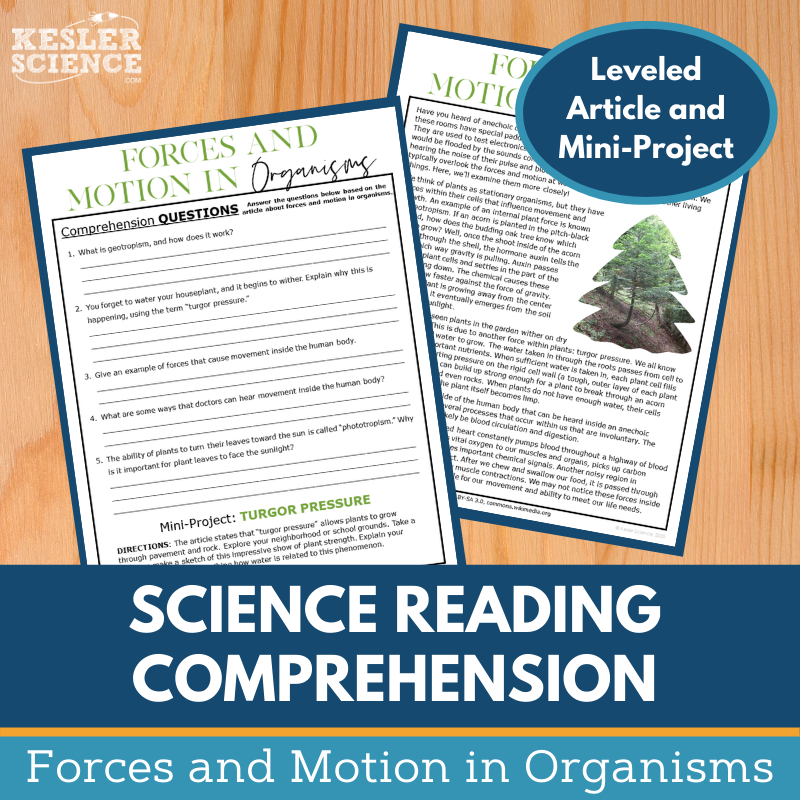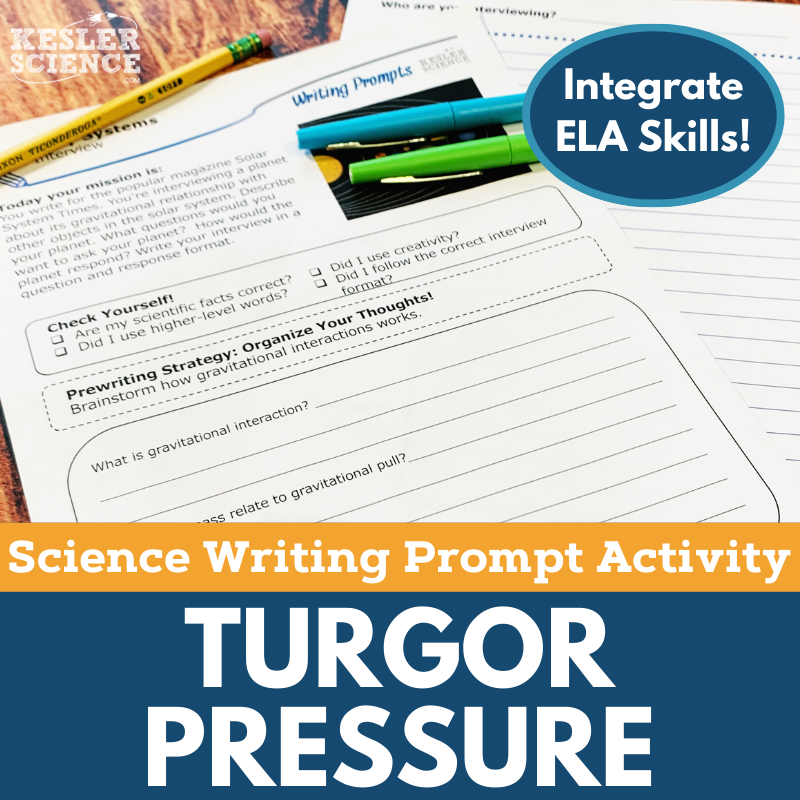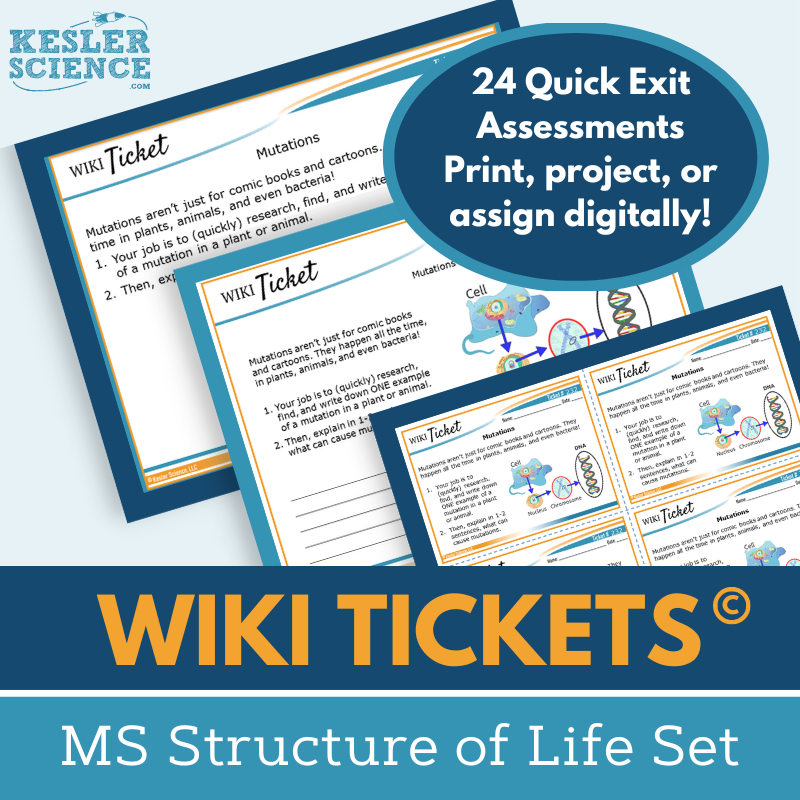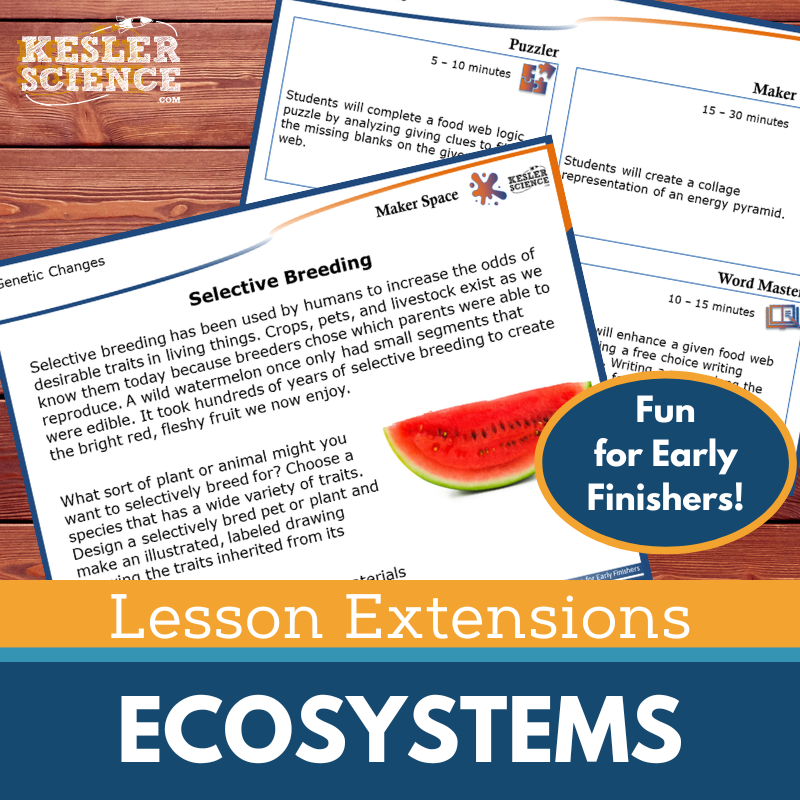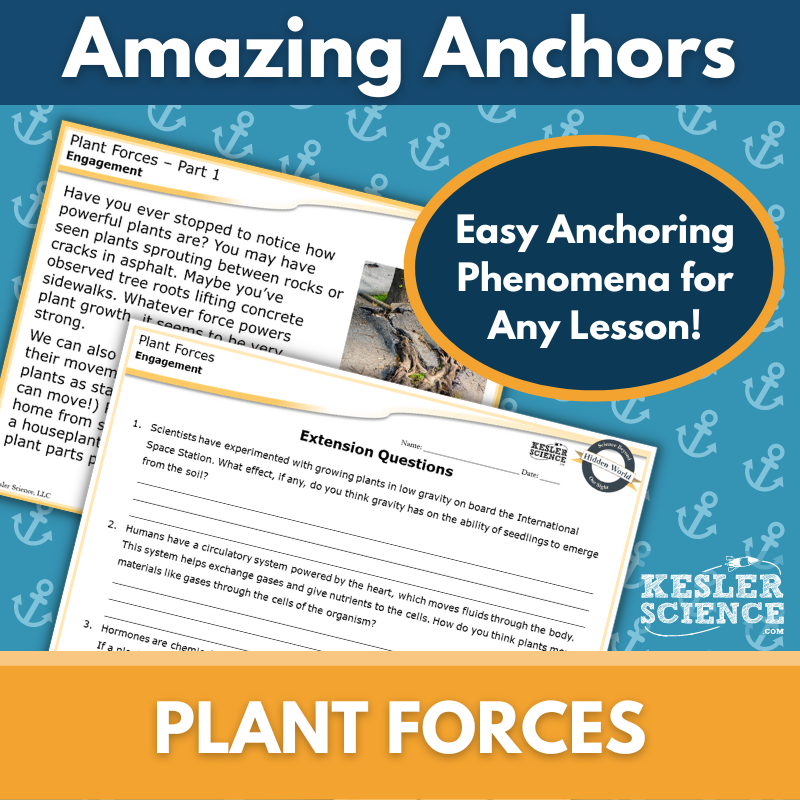Tropisms and Turgor Pressure Activities for Middle School Science
The Kesler Science Turgor Pressure and Tropisms resources provide a comprehensive, student-centered approach to exploring plant responses to environmental stimuli. The resources below will give students a comprehensive understanding of tropisms and turgor pressure. All of the following materials are also included in the Kesler Science Membership.
The Kesler Science Tropisms and Turgor Pressure Complete 5E Lesson is designed for middle school students to explore how plants respond to environmental stimuli and the effects of turgor pressure. Using the 5E Model, this lesson includes fully editable PowerPoints, worksheets, and a range of activities, including student-led projects and assessments. Students will answer key questions like, "What are the different types of tropisms?" and "How does turgor pressure affect a plant?"
In the Exploration phase, students engage with nine differentiated stations that help them understand the core concepts through multimodal learning. These stations include "Explore It!" with hands-on demonstrations, "Read It!" with leveled reading passages, and "Watch It!" with videos. Output stations allow students to organize their knowledge, create visual models, and assess their understanding through task cards and written responses. A bonus challenge station offers additional enrichment for early finishers.
The lesson culminates in the Elaboration phase with student-choice projects to extend learning, both in-class or at home. The Evaluation phase includes comprehensive assessments, with updated questions available in dependent and modified versions. The lesson also provides support with vocabulary cards, teacher notes, and interactive notebook templates in multiple formats to ensure an engaging and differentiated experience for all learners.
The Kesler Science Tropisms and Turgor Pressure Complete 5E Lesson is designed for middle school students to explore how plants respond to environmental stimuli and the effects of turgor pressure. Using the 5E Model, this lesson includes fully editable PowerPoints, worksheets, and a range of activities, including student-led projects and assessments. Students will answer key questions like, "What are the different types of tropisms?" and "How does turgor pressure affect a plant?"
In the Exploration phase, students engage with nine differentiated stations that help them understand the core concepts through multimodal learning. These stations include "Explore It!" with hands-on demonstrations, "Read It!" with leveled reading passages, and "Watch It!" with videos. Output stations allow students to organize their knowledge, create visual models, and assess their understanding through task cards and written responses. A bonus challenge station offers additional enrichment for early finishers.
The lesson culminates in the Elaboration phase with student-choice projects to extend learning, both in-class or at home. The Evaluation phase includes comprehensive assessments, with updated questions available in dependent and modified versions. The lesson also provides support with vocabulary cards, teacher notes, and interactive notebook templates in multiple formats to ensure an engaging and differentiated experience for all learners.
The Kesler Science Turgor Pressure and Tropisms Station Lab is a modular, student-led activity that engages middle school students in learning about turgor pressure and tropisms. With eight differentiated activities and a ninth challenge station for advanced learners, students have the opportunity to take charge of their learning. This student-centered approach ensures that teachers facilitate rather than direct the learning process.
The stations are divided into input and output activities. Input stations such as "Explore It!" and "Research It!" allow students to engage with multimodal content through hands-on demonstrations, digital research, and reading passages. At output stations like "Organize It!" and "Write It!" students can demonstrate their understanding through hands-on activities, creative sketches, and written responses.
This station lab is designed for both in-person and virtual learning environments, providing all necessary resources, signage, and task cards for students to complete the stations independently or in small groups. Teachers can easily adapt the stations to fit their classroom needs while helping students deepen their understanding of important science concepts.
The Kesler Science Turgor Pressure and Tropisms Station Lab is a modular, student-led activity that engages middle school students in learning about turgor pressure and tropisms. With eight differentiated activities and a ninth challenge station for advanced learners, students have the opportunity to take charge of their learning. This student-centered approach ensures that teachers facilitate rather than direct the learning process.
The stations are divided into input and output activities. Input stations such as "Explore It!" and "Research It!" allow students to engage with multimodal content through hands-on demonstrations, digital research, and reading passages. At output stations like "Organize It!" and "Write It!" students can demonstrate their understanding through hands-on activities, creative sketches, and written responses.
This station lab is designed for both in-person and virtual learning environments, providing all necessary resources, signage, and task cards for students to complete the stations independently or in small groups. Teachers can easily adapt the stations to fit their classroom needs while helping students deepen their understanding of important science concepts.
The Kesler Science Tropisms and Turgor Pressure Student Choice Projects offer middle school students the flexibility to choose projects that align with their learning style. Students can select from six project options or create their own, with the choice board allowing for creative expression in demonstrating their understanding of tropisms and turgor pressure. A grading rubric is included for assessments, which can be used by teachers, peers, or the students themselves.
These dynamic and multimodal projects cater to a range of learners, with differentiated options to ensure every student can participate and succeed. The teacher directions provide clear guidance and suggestions, while the editable rubric helps assess vocabulary, concepts, presentation, and accuracy. The resource includes two versions of the project page, one with additional support for students needing remediation and another offering a challenge for advanced learners.
The projects require minimal supplies, mostly everyday classroom materials like paper, markers, and scissors, with some projects being able to be completed digitally. This flexibility makes the Student Choice Projects easy to integrate into both in-person and virtual learning environments, giving students the opportunity to engage in creative, personalized learning while reinforcing important science concepts.
The Kesler Science Tropisms and Turgor Pressure Student Choice Projects offer middle school students the flexibility to choose projects that align with their learning style. Students can select from six project options or create their own, with the choice board allowing for creative expression in demonstrating their understanding of tropisms and turgor pressure. A grading rubric is included for assessments, which can be used by teachers, peers, or the students themselves.
These dynamic and multimodal projects cater to a range of learners, with differentiated options to ensure every student can participate and succeed. The teacher directions provide clear guidance and suggestions, while the editable rubric helps assess vocabulary, concepts, presentation, and accuracy. The resource includes two versions of the project page, one with additional support for students needing remediation and another offering a challenge for advanced learners.
The projects require minimal supplies, mostly everyday classroom materials like paper, markers, and scissors, with some projects being able to be completed digitally. This flexibility makes the Student Choice Projects easy to integrate into both in-person and virtual learning environments, giving students the opportunity to engage in creative, personalized learning while reinforcing important science concepts.
The Kesler Science Ecosystems Interactive Notebook Bundle provides an engaging and interactive way for students to explore key ecosystems concepts. Designed for flexibility, the resource includes both print and digital versions, making it suitable for traditional classrooms, 1:1 environments, and distance learning settings.
The bundle covers a wide range of topics, including biotic and abiotic factors, biomes, food webs, symbiosis, and the nitrogen and carbon cycles. Digital features include a unique interactive notebook PowerPoint, editable Google Slides compatibility, reflection pages, and modified versions for students with accommodations. The paper version includes blank and pre-filled templates, complete with color examples to guide students and teachers.
This resource supports differentiated instruction and accommodates all learners with thoughtfully designed templates and modifications. Whether in person or online, the Ecosystems Interactive Notebook promotes active learning, critical thinking, and scientific literacy.
The Kesler Science Ecosystems Interactive Notebook Bundle provides an engaging and interactive way for students to explore key ecosystems concepts. Designed for flexibility, the resource includes both print and digital versions, making it suitable for traditional classrooms, 1:1 environments, and distance learning settings.
The bundle covers a wide range of topics, including biotic and abiotic factors, biomes, food webs, symbiosis, and the nitrogen and carbon cycles. Digital features include a unique interactive notebook PowerPoint, editable Google Slides compatibility, reflection pages, and modified versions for students with accommodations. The paper version includes blank and pre-filled templates, complete with color examples to guide students and teachers.
This resource supports differentiated instruction and accommodates all learners with thoughtfully designed templates and modifications. Whether in person or online, the Ecosystems Interactive Notebook promotes active learning, critical thinking, and scientific literacy.
The Kesler Science Tropisms and Turgor Pressure Inquiry Lab engages students in exploring how plant cell vacuoles respond to varying saltwater concentrations and how these changes impact turgor pressure. Students either follow a virtual lab with a demonstration video or conduct a hands-on experiment using simple classroom materials like potato slices, salt, and water. Both formats include comprehension questions, Claim-Evidence-Reasoning (C.E.R.) prompts, and a reflection section to reinforce understanding.
This lab supports diverse learners with three differentiated versions—Modified, Dependent, and Independent—offering varying degrees of structure and guidance. Students investigate the relationship between vacuoles and turgor pressure, gaining insights into cellular functions and plant health. The Modified version includes sentence stems and multiple-choice options, the Dependent version guides students through structured inquiry, and the Independent version allows advanced learners more autonomy.
Teachers receive editable files, answer keys, and comprehensive teacher pages for easy implementation. The resource is compatible with Google Slides and PowerPoint, and the digital version includes an embedded video to guide students through the procedure, making it ideal for both in-person and remote instruction.
The Kesler Science Tropisms and Turgor Pressure Inquiry Lab engages students in exploring how plant cell vacuoles respond to varying saltwater concentrations and how these changes impact turgor pressure. Students either follow a virtual lab with a demonstration video or conduct a hands-on experiment using simple classroom materials like potato slices, salt, and water. Both formats include comprehension questions, Claim-Evidence-Reasoning (C.E.R.) prompts, and a reflection section to reinforce understanding.
This lab supports diverse learners with three differentiated versions—Modified, Dependent, and Independent—offering varying degrees of structure and guidance. Students investigate the relationship between vacuoles and turgor pressure, gaining insights into cellular functions and plant health. The Modified version includes sentence stems and multiple-choice options, the Dependent version guides students through structured inquiry, and the Independent version allows advanced learners more autonomy.
Teachers receive editable files, answer keys, and comprehensive teacher pages for easy implementation. The resource is compatible with Google Slides and PowerPoint, and the digital version includes an embedded video to guide students through the procedure, making it ideal for both in-person and remote instruction.
This Forces and Motion in Organisms Science Reading Comprehension Lesson introduces students to the physical forces that impact living organisms, such as the emergence of seedlings, turgor pressure, geotropism, and blood circulation. Through a leveled nonfiction article and corresponding comprehension questions, students deepen their understanding of these biological processes. As a follow-up, students apply their learning by identifying and explaining a real-world example of turgor pressure.
Designed for middle school science students, the resource includes two leveled articles with Lexile levels between 1100 and 1300, a hands-on mini-project, and five to seven comprehension questions per passage. A Cornell notes template is included, and the materials feature visually engaging graphics that can be printed in grayscale.
The lesson is ideal for a variety of instructional settings, including in-class learning, sub plans, ISS, and distance learning via platforms like Google Classroom, MS Teams, and Canvas. Students can respond directly within editable digital files, making it easy to integrate into any LMS. This resource supports science literacy, reading comprehension, and classroom discussions while reinforcing core content knowledge.
This Forces and Motion in Organisms Science Reading Comprehension Lesson introduces students to the physical forces that impact living organisms, such as the emergence of seedlings, turgor pressure, geotropism, and blood circulation. Through a leveled nonfiction article and corresponding comprehension questions, students deepen their understanding of these biological processes. As a follow-up, students apply their learning by identifying and explaining a real-world example of turgor pressure.
Designed for middle school science students, the resource includes two leveled articles with Lexile levels between 1100 and 1300, a hands-on mini-project, and five to seven comprehension questions per passage. A Cornell notes template is included, and the materials feature visually engaging graphics that can be printed in grayscale.
The lesson is ideal for a variety of instructional settings, including in-class learning, sub plans, ISS, and distance learning via platforms like Google Classroom, MS Teams, and Canvas. Students can respond directly within editable digital files, making it easy to integrate into any LMS. This resource supports science literacy, reading comprehension, and classroom discussions while reinforcing core content knowledge.
The Kesler Science Turgor Pressure Science Writing Prompt Activity engages middle school students in testing their understanding of life science through a creative print advertisement project. Students will explore the concept of turgor pressure while developing their writing skills in a fun and interactive way. This activity encourages both science reasoning and writing enrichment, and is designed to be easily adapted for virtual learning environments.
Included in the resource are teacher directions, rubrics, and a variety of formats to suit different learning styles. The full-sized and half-sheet handouts provide templates for the print advertisement, along with pre-writing strategies and self-checks to guide students through the process. The digital interactive version, compatible with PowerPoint or Google Slides, makes it easy to assign and complete the project in-class or remotely.
Perfect for a variety of uses, including cross-curricular integration, pre-test assessments, student choice projects, and differentiation, this resource supports diverse learning needs. It can also serve as an elaboration activity for early finishers or as extra credit. Whether displayed on bulletin boards or collected in student anthologies, this activity offers a flexible and engaging way to reinforce key life science concepts.
The Kesler Science Turgor Pressure Science Writing Prompt Activity engages middle school students in testing their understanding of life science through a creative print advertisement project. Students will explore the concept of turgor pressure while developing their writing skills in a fun and interactive way. This activity encourages both science reasoning and writing enrichment, and is designed to be easily adapted for virtual learning environments.
Included in the resource are teacher directions, rubrics, and a variety of formats to suit different learning styles. The full-sized and half-sheet handouts provide templates for the print advertisement, along with pre-writing strategies and self-checks to guide students through the process. The digital interactive version, compatible with PowerPoint or Google Slides, makes it easy to assign and complete the project in-class or remotely.
Perfect for a variety of uses, including cross-curricular integration, pre-test assessments, student choice projects, and differentiation, this resource supports diverse learning needs. It can also serve as an elaboration activity for early finishers or as extra credit. Whether displayed on bulletin boards or collected in student anthologies, this activity offers a flexible and engaging way to reinforce key life science concepts.
The WIKI Tickets© formative assessments offer flexible, engaging ways to check student understanding of life science concepts in grades 6–8. This Structure of Life Set includes 24 assessments covering topics such as cell theory, reproduction, heredity, homeostasis, internal structures, and turgor pressure. Each assessment is available in five formats: a full-screen projection, three print handout sizes, and an interactive digital version for PowerPoint or Google Slides.
All WIKI Tickets© are aligned with NGSS and TEKS middle school science standards. Each topic has at least one aligned ticket, and some topics include multiple options. A table of contents file is included to show standard alignment, making it easy to integrate these assessments into your curriculum.
These versatile tools can be used as bellringers, exit tickets, or quick formative checks in both in-person and virtual classrooms. Whether students respond using paper, digital slides, or a projected prompt, WIKI Tickets© offer a colorful and adaptable way to gauge student learning at any point in the lesson.
The WIKI Tickets© formative assessments offer flexible, engaging ways to check student understanding of life science concepts in grades 6–8. This Structure of Life Set includes 24 assessments covering topics such as cell theory, reproduction, heredity, homeostasis, internal structures, and turgor pressure. Each assessment is available in five formats: a full-screen projection, three print handout sizes, and an interactive digital version for PowerPoint or Google Slides.
All WIKI Tickets© are aligned with NGSS and TEKS middle school science standards. Each topic has at least one aligned ticket, and some topics include multiple options. A table of contents file is included to show standard alignment, making it easy to integrate these assessments into your curriculum.
These versatile tools can be used as bellringers, exit tickets, or quick formative checks in both in-person and virtual classrooms. Whether students respond using paper, digital slides, or a projected prompt, WIKI Tickets© offer a colorful and adaptable way to gauge student learning at any point in the lesson.
The Kesler Science Ecosystems Lesson Extensions offer student-choice activities to challenge fast finishers and encourage critical thinking. These activities provide engaging ways to deepen learning and can be used to wrap up lessons, prevent distractions, or fill gaps during testing. Each extension is designed to scaffold learning with activities that align with NGSS and TEKS standards, making them perfect for students ready to explore topics like ecosystems in more depth.
Included in each Lesson Extension are four activity types: Puzzler, Maker Space, Tech Connection, and Word Master. These activities focus on problem-solving, STEAM connections, digital media, and creative writing, providing opportunities for students to apply their knowledge in diverse and engaging ways. Both digital and paper versions are available, with teacher directions and answer keys for easy implementation.
These extensions are ideal for pushing independent learners further, offering rigorous, fun, and hands-on learning opportunities. With topics ranging from biodiversity to ecosystems and environmental changes, these resources help extend students' understanding of science concepts while reinforcing critical skills.
The Kesler Science Ecosystems Lesson Extensions offer student-choice activities to challenge fast finishers and encourage critical thinking. These activities provide engaging ways to deepen learning and can be used to wrap up lessons, prevent distractions, or fill gaps during testing. Each extension is designed to scaffold learning with activities that align with NGSS and TEKS standards, making them perfect for students ready to explore topics like ecosystems in more depth.
Included in each Lesson Extension are four activity types: Puzzler, Maker Space, Tech Connection, and Word Master. These activities focus on problem-solving, STEAM connections, digital media, and creative writing, providing opportunities for students to apply their knowledge in diverse and engaging ways. Both digital and paper versions are available, with teacher directions and answer keys for easy implementation.
These extensions are ideal for pushing independent learners further, offering rigorous, fun, and hands-on learning opportunities. With topics ranging from biodiversity to ecosystems and environmental changes, these resources help extend students' understanding of science concepts while reinforcing critical skills.
This Amazing Anchors Phenomenon Lesson introduces and reinforces the concept of plant forces through real-world connections. Students begin with an introductory reading focused on tree roots, followed by comprehension and extension questions to spark curiosity and build background knowledge. An explanatory reading then unpacks the science behind plant forces, helping students deepen their understanding through additional reinforcement questions.
The resource includes teacher directions with answer keys, projection slides for class display, and both print and digital handouts in full- and half-sheet formats. All materials are fully editable and aligned with TEKS standards, making it easy to integrate into existing lesson plans. A differentiated version supports student comprehension with simplified language and sentence starters.
Designed to support the Engagement and Elaborate phases of the 5E Model, this lesson is ideal for introducing and wrapping up a unit on plant forces. It works well in both in-person and virtual settings, with flexible formats that allow for seamless digital or paper-based use.
This Amazing Anchors Phenomenon Lesson introduces and reinforces the concept of plant forces through real-world connections. Students begin with an introductory reading focused on tree roots, followed by comprehension and extension questions to spark curiosity and build background knowledge. An explanatory reading then unpacks the science behind plant forces, helping students deepen their understanding through additional reinforcement questions.
The resource includes teacher directions with answer keys, projection slides for class display, and both print and digital handouts in full- and half-sheet formats. All materials are fully editable and aligned with TEKS standards, making it easy to integrate into existing lesson plans. A differentiated version supports student comprehension with simplified language and sentence starters.
Designed to support the Engagement and Elaborate phases of the 5E Model, this lesson is ideal for introducing and wrapping up a unit on plant forces. It works well in both in-person and virtual settings, with flexible formats that allow for seamless digital or paper-based use.
Year-Round Resources
These year-round activities will increase your students' understanding of many middle school science topics. All of these activities are also included in the Kesler Science Membership.
Visual Data & Graphing
You're not alone if your students struggle with understanding graphs, charts, and tables. It's a skill that takes an enormous amount of practice. This resource will help students build a strong foundation in analyzing data and creating their own data visualizations.
Bell Ringers and Warm-Ups
These middle school science bell ringers are an excellent way to engage your students as soon as they walk into your classroom. This comprehensive FULL YEAR resource includes everything you need to start off each science class with an interesting warm-up activity.
Review Board Games
Each game board has been carefully designed to keep students engaged. There are 10 different action spaces on each board and dozens of question cards. All of the actions are related to science concepts and keep the students motivated throughout the game.
Each game is ready to play. Simply print out the board and the cards and let the students enjoy reviewing nine different units.
Essential Questions
Below are the essential questions associated with the lessons and activities included in this unit. This topic is only one of more than 100 middle school science topics included in the Kesler Science Membership.
-
In what ways do plants respond to stimuli?
-
What are four different types of tropisms?
-
How does turgor pressure affect a plant?
Kesler Science Membership
Imagine never having to search for another middle school science lesson again. The membership gives you access to ALL of the Kesler Science products in one place (Yes, including everything above).
Say goodbye to long hours of lesson prep.

